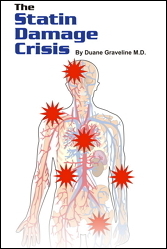Mitochondrial Mutations and Statins
The existence in our cells of what could be called an alien genome, our mitochondrial organelles, introduces an unusual twist of biology in our inheritance patterns.
Mitochondria are organelles that provide much of the energy cells use for the work they do. Most biologists now believe that these structures evolved from microorganisms that established symbiotic relationships with the ancestors of animal cells very early in the history of life on this planet. Survival advantage explains how it has come to be that mitochondria contain their own DNA that codes for 13 of their proteins along with RNA that specifically helps express mitochondrial information.
As with any form of DNA, mitochondrial DNA (mtDNA) sequences are susceptible to mutation In fact, there is evidence that mitochondrial sequences may mutate at rates 3 to 5 times greater than nuclear sequences. This may be because of the front-line position of these tiny warriors in their battle to use oxygen without themselves being oxidized. Constantly at risk they ordinarily are well supplied with anti-oxidants.
When cells divide, their mitochondria independently replicate and then distribute randomly into daughter cells. This leads to variable expressions within and among tissues ranging from non-viable cells (hence death of tissue), to energy generation dysfunction, to sub threshold changes (i.e. "silent" mutations) that do not affect overall cell function. What this means is that mitochondrial mutations may be variable in their clinical presentation, depending on their timing and prevalence.
A number of specific disorders have been described where mitochondrial mutations are either inherited or occur early enough in development to dominate most cells. Mitochondria are passed from generation to generation only through maternal egg cells where they are abundant.
Although mitochondrial inheritance looks easy to identify it must be remembered that expression variability is a hallmark for these disorders. Therefore, a family history where some individuals present with strokes, others with muscle weakness, and still others with psychiatric complaints might not be immediately recognizable as one expressing a single mitochondrial mutation.
It is likely, however, that since mitochondrial mutations are frequent, there are many new yet to be discovered. Statin associated chronic neuropathy and chronic myopathy may well be examples of this process in action. It seems likely that a side effect of statin drugs in some people is to trigger just this process - mitochondrial mutations of sufficient frequency and severity to express as a chronic, even progressive condition. Indeed, it is known that accumulating mitochondrial mutations contribute significantly to aging. This appears to be what we might be seeing in the thousands of reports of permanent muscle wasting, weakness and neuropathies seen usually only in advanced age.
Variability of expression may well explain why some people seem extraordinarily sensitive, showing symptoms early, while others show no apparent effect but may well be victims of low-grade, accelerated aging type of presentation, taking years to become evident. This may also helps to explain why some people may be on a statin at unchanged dose for years before abruptly manifesting symptoms.
Duane Graveline MD MPH
Former USAF Flight Surgeon
Former NASA Astronaut
Retired Family Doctor






